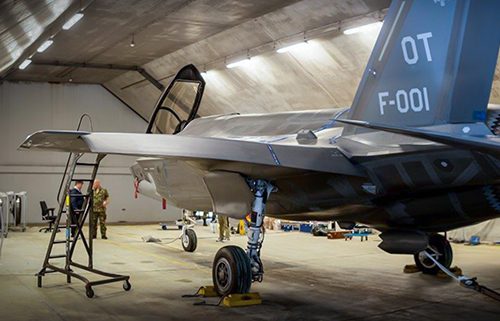In 2019 the first F-35 fighter aircraft will start operating from bases in the Netherlands. As part of the necessary preparations, the Dutch Ministry of Defence is examining the shelters in which the aircraft will be stored. Can F-35s operate safely from the Hardened Aircraft Shelters (HASs) at the air force bases in Leeuwarden and Volkel? A large international team that included NLR performed a measurement to answer this question during a recent visit made by two F-35 aircraft to the Netherlands. The team concluded that the HASs are suitable for the new fighter aircraft.
The Royal Netherlands Air Force (RNLAF) has been using these shelters to store fighters ever since the introduction of the F-104Â Starfighter. Both Leeuwarden Air Base and Volkel Air Base have several of these hardened concrete hangars, with each shelter able to accommodate one aircraft. The plane must be able to start up inside the shelter for operational missions. What impact does this have on noise and gas emissions inside the hangar? NLR investigated whether the gases released are hazardous to the health of air base personnel, and if adequate gas exhaust measures are in place. It should be noted that the F-35 is not equipped with an oxygen cylinder system for the pilot, unlike the F-16. Instead, the F-35 generates oxygen from the ambient air and supplies it to the pilot. The concentrations of hazardous gases inhaled by pilots and maintenance engineers must remain below certain limit values regarded as safe.
The Defence Materiel Organization (DMO) of the Royal Netherlands Air Force commissioned NLR to investigate the emissions of various hazardous gases, including carbon monoxide (CO), carbon dioxide (CO2), nitrogen monoxide (NO) and nitrogen dioxide (NO2). Using a range of methods for measuring gas and dust concentrations, NLR conducted a detailed study of the concentrations in emissions resulting from the operation of F-35Â aircraft in Hardened Aircraft Shelters. A ‘test run’ with an F-16 was carried out before focusing on the F-35. NLR also analyzed the temperature of the emissions.
NLR completed its study report in early November 2016. The main conclusion was that HAS shelters are suitable for F-35 aircraft with respect to gas emissions and temperatures. The Ministry of Defence judged the measurements performed by NLR to be successful. Further to the findings of the report, the Defence Materiel Organization and various partners including the United States Air Force will certify HAS shelters for the operational deployment of F-35 aircraft.



